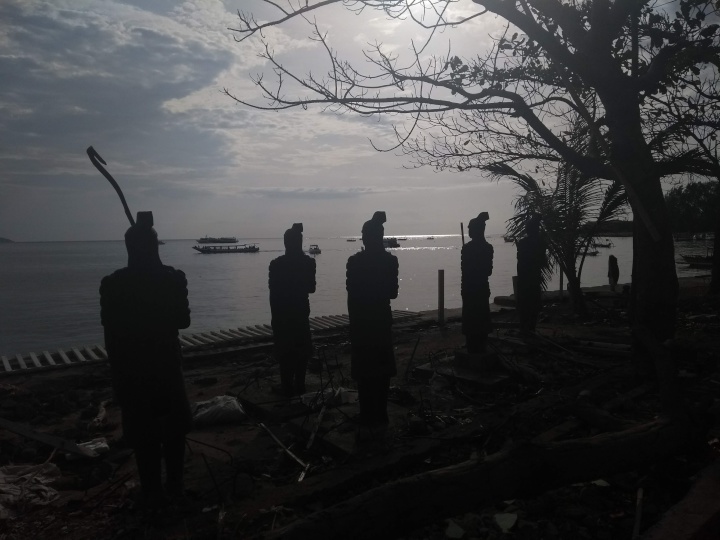
Replica terracotta warrior statues stand sentry over earthquake damage on Gili Air – All photos Joseph Cederwall
2018 was a difficult year for the Indonesian archipelago. This chain of fragile and largely low-lying islands is situated on a particularly unstable segment of the Pacific rim of fire. Last year the islands were hit by a series of devastating natural events including a series of Lombok, Sulawesi and Java based earthquakes and resultant tsunamis. On Sunday 5 August an earthquake caused extensive damage to the region. The 6.9 magnitude earthquake was centred on the North of the island of Lombok, and was followed by a succession of powerful aftershocks over the next few days, many nearly as strong as the original earthquake. The quake also caused damage to Bali nearly 100 miles away.
The quake, left 563 people dead, more than 1,000 injured and more than 417,000 people displaced from their homes. Authorities estimate that the cost of the damage across Lombok and the Gili Islands and exceeded 8.8 trillion rupiah (~USD 600 million) (NZD 100m). Worst of all, however, is the unquantifiable devastation to the environment, community and economy of these already poverty stricken islands. I travelled to the second largest Island in the Gili Island chain, Gili Air (literally translated as Gili Water) in October 2018 to talk to people about their experiences of the event and witness the impact and the rebuild efforts on this unique ecotourism destination.
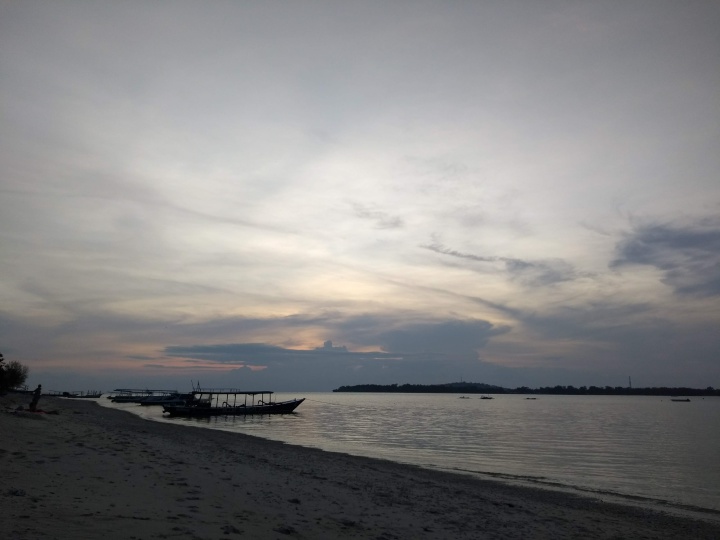
The famous Gili Air Sunset is a big tourist drawcard
The indigenous people of these islands are of the pre-Islamic Sasak culture, a semi-nomadic seafaring people who spread throughout the islands with a livelihood based on subsistence culture of fishing, trading and cultivation. However, today tourism is the biggest industry in their economy, and as expected this was hit hard by the natural disasters. Many tourists are scared off by the earthquakes and will still visit the Bali mainland but are still seemingly reluctant to visit the low lying islands such as Sulawesi and the highly popular ecotourism destination of the Gili Islands.
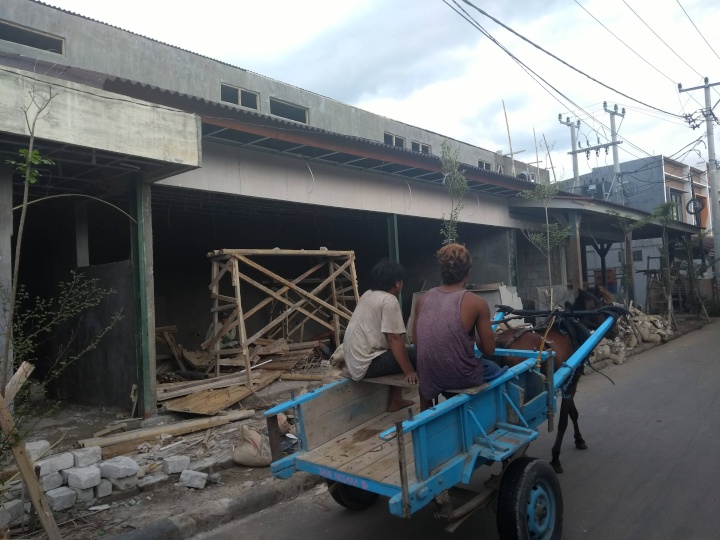
Horse and cart are widely used for transport on the Gili islands
I love the Gili Islands, they are like stepping back in time as no petrol vehicles or generators are allowed on the islands. They are Isles with no dogs but many stray cats, no petrol cars or scooters but coconut palm oil powered scooters, E-bikes and electric mopeds, and even horse and carts. The Sasak of the Gilis are a friendly, resilient, devoutly Muslim and community-focused people. They have made the best of a difficult task of rebuilding and welcoming back the tourists and I saw evidence of a highly community oriented and cooperative rebuild. I encourage people to consider going there and helping out with getting the economy back on track, the Government advisories all advise that there is no more chance now than at any other time of a repeat disaster. The simple fact is if you live in New Zealand, you are just as likely to suffer a natural disaster at home as on holiday in the Islands.
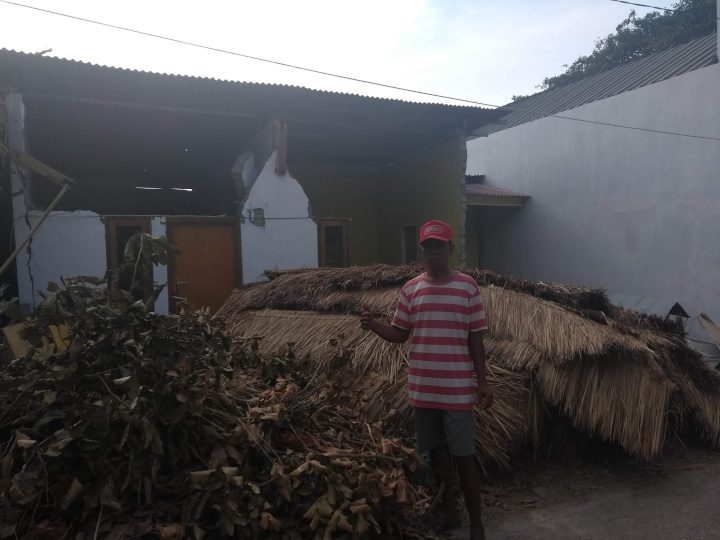
Ibrahim in front of his sister's house
I met Bram (Ibrahim) reconstructing a house owned by his sister. She had long since fled the islands for the Lombok mainland along with her family and many of its inhabitants. The extended family, including Bram, had come from other nearby Islands and the mainland to help rebuild. Bram greeted me with a cordial “Kia ora mate” when he discovered I was from New Zealand, and told me he normally worked on the main Island Gili Trawangan in a luxury resort owned by Kiwi extreme sports legend AJ Hackett, Pondok Santi Estate.
Bram said his sister and family were still in Government shelters in the main Lombok harbour like many displaced victims and he was unsure how they were going to rebuild as they had no money to do so. They were still cleaning up and assessing the damage to see what would be possible and how much it might cost.

Hil in front of the remains of her family's destroyed home
Hil and her Brother and Mother were also trying their best to clean up the devastation and wanted to rebuild their hose. However, she said she didn’t know if they will be able to as they have no money. She said “Inshallah” (God willing), maybe next year or in two years they would be able to rebuild the house.
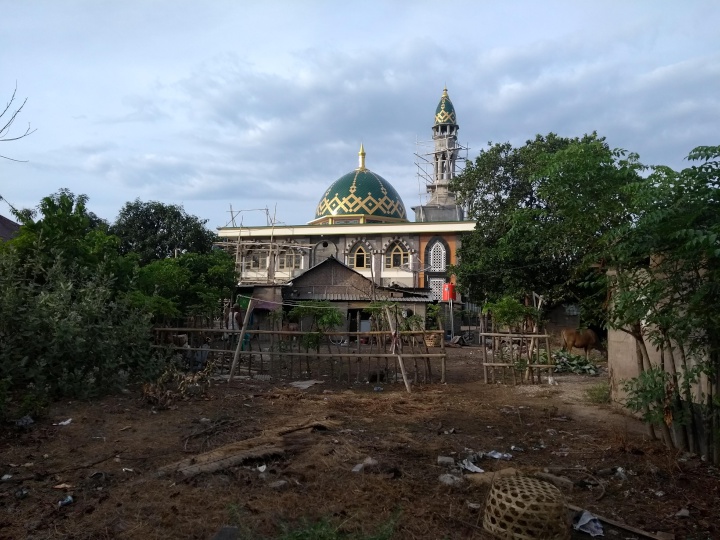
Gili Air Mosque with scaffolding
There was more advanced construction work going on everywhere. It seemed that many of the tourism businesses had money to rebuild. Even the Island’s picturesque Mosque, a central community asset, had apparently suffered damage and was being rebuilt.
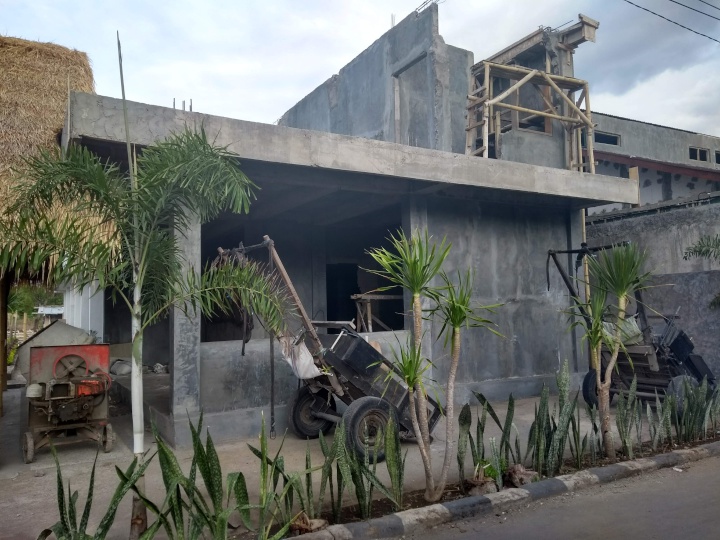
Interestingly, many of the rebuilds appeared to be happening with concrete blocks and little or no steel, despite the fact that this was the type of construction that fared worst in the earthquakes.
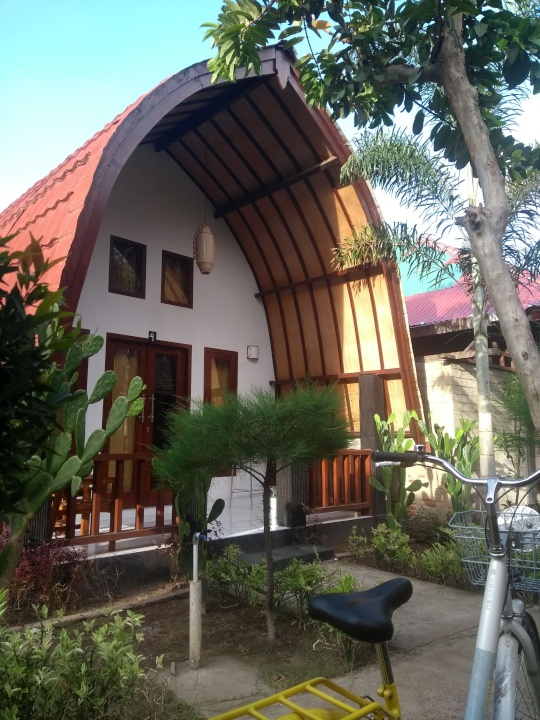
Traditional Sasak Lumpung Huts
In contrast, the traditional Sasak architecture of the style I stayed in at Gili Santay Resort were almost undamaged by the Earthquakes. The traditional “Lumpung” or Bamboo huts were built to flex with the shake and survived largely unscathed. There is a strong lesson in resilience through natural building materials and traditional knowledge to be learned from this. However it seems that some have simply ignored this lesson, particularly the buildings in the main streets of the village.
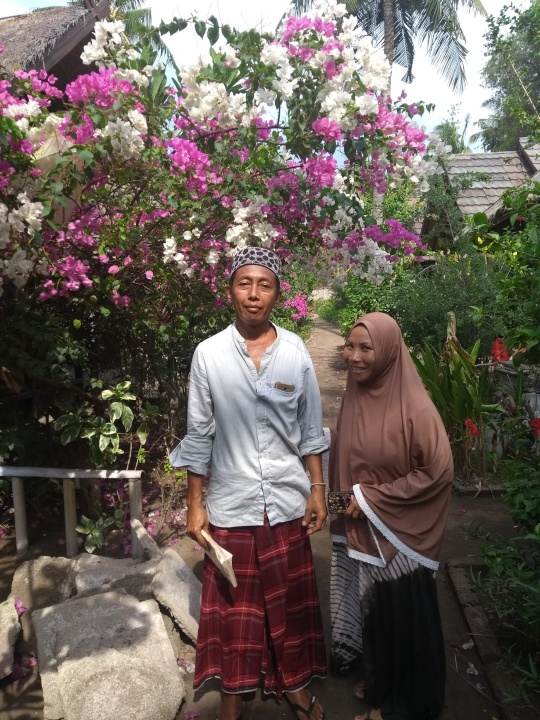
Hani and Ibrahaim - Managers at Santay resort Gili Air
Hani and her husband are the managers of
Gili Santay. Hani told me that when the quakes hit Santay
hostel there were over 100 tourists here. I was there still
technically in the high season, but I was the only guest for
most of the time.
She said many of the guests were
hysterical with fear about a predicted tsunami. There were
no boats and no time to evacuate from the island and with no
electricity, communications and information must have been
impossible. She and her husband evacuated them all up a
small hill at the back of the island. By NZ standards, this
is little more than a bump in the road, but it was the
closest they have to high ground. Fortunately for them no
large tsunami arrived in the Gilis, but struck Sulawesi and
North Lombok causing havoc there. The family then pitched
tents on the lawn and the guests all slept outside until
boats could safely evacuate both tourists and residents to
Lombok.
Lessons from Gili Air
This island suffered surprisingly little damage and appeared to be bouncing back relatively quickly given the severity of the earthquakes. There were a few things going for the islands such as the highly decentralised electricity grid based on renewable energy, the decentralised waste treatment system, the resilience of the traditional natural building style and the community mindedness of the inhabitants. Last year Charlotte Graham wrote for Scoop about the theme of empowering communities to act in response to disasters. This Gili Island example should give us all in New Zealand something to consider when planning any future post disaster rebuilds, or planning for climate-based catastrophe. It is well proven by examples such as this one that a decentralised and renewable based system and a strong community are key elements in resilience.


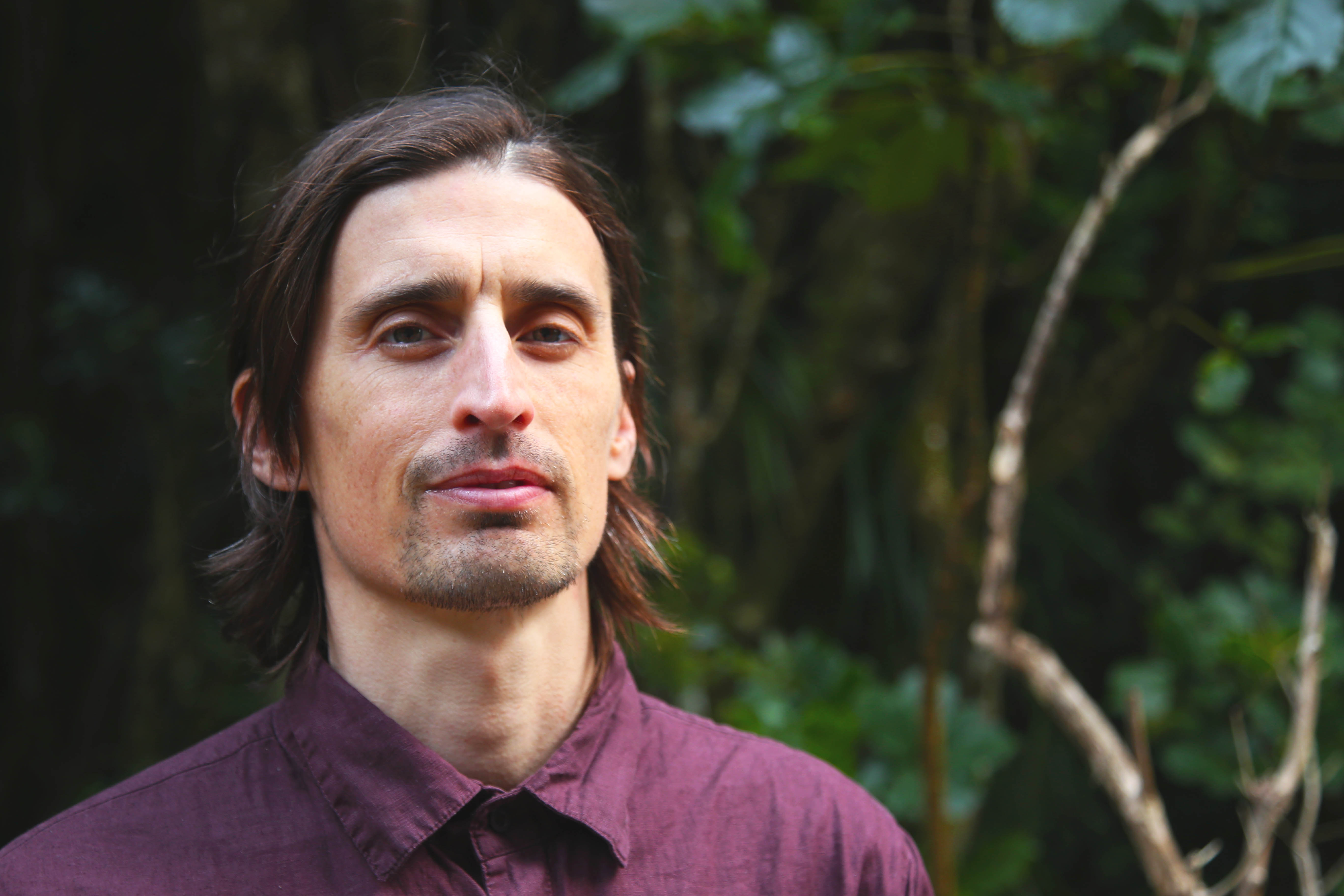
 Eugene Doyle: Disruption - Historians Challenge Russophobic Propaganda
Eugene Doyle: Disruption - Historians Challenge Russophobic Propaganda Ramzy Baroud: War, Doublethink, And The Struggle For Survival - Geopolitics Of The Gaza Genocide
Ramzy Baroud: War, Doublethink, And The Struggle For Survival - Geopolitics Of The Gaza Genocide Binoy Kampmark: Authoritarian Politics - Netanyahu’s War On Israeli Institutions
Binoy Kampmark: Authoritarian Politics - Netanyahu’s War On Israeli Institutions Keith Rankin: Learning The Correct Lessons From World War Two In Europe
Keith Rankin: Learning The Correct Lessons From World War Two In Europe Ramzy Baroud: Arab Failures - The Unspoken Complicity In Israel's Genocide
Ramzy Baroud: Arab Failures - The Unspoken Complicity In Israel's Genocide Peter Dunne: Dunne's Weekly - The 'War On Woke' Is Really Just A 'War Of Words'
Peter Dunne: Dunne's Weekly - The 'War On Woke' Is Really Just A 'War Of Words'